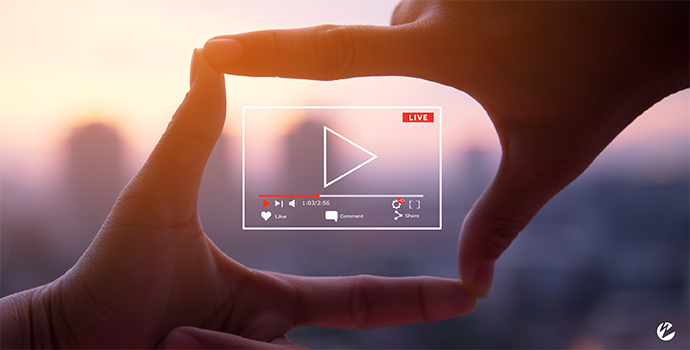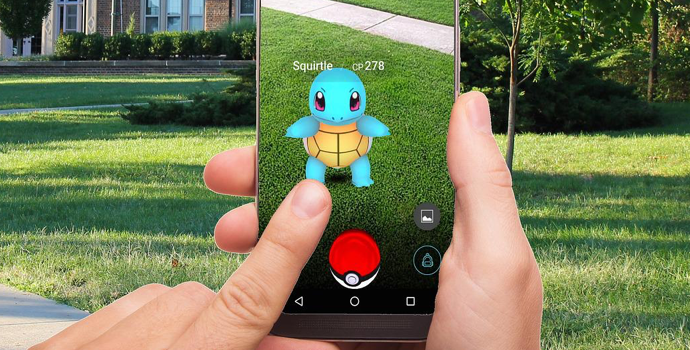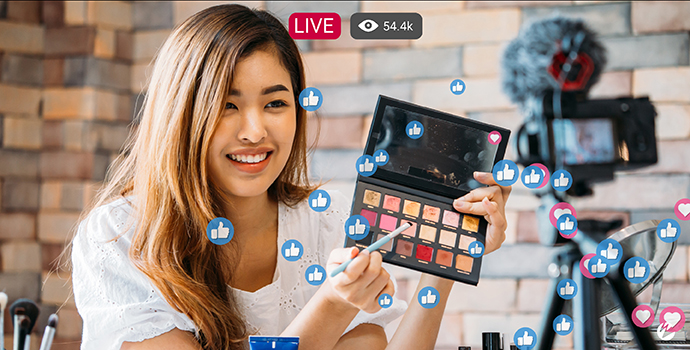Online Video Trends 2023: What They Are and How They Benefit You (Update)

Today’s typical consumer doesn’t like to feel sold to, but that’s not to say they won’t appreciate your brand and what it has to offer. They want brands with personality, brands that produce substantive and meaningful content, and brands that adapt fluidly to the ever changing technological and social landscape. All these attributes add up to a company that cares, pays attention, and makes an effort.
So, what is this technological and social landscape as we continue to put the pandemic in our rearview mirror? In a word: video. And that’s not just the sort of video that put you in touch with your team at work for remote meetings or aided you in socially distanced medical appointments. It’s video that has been sliding into your social media feeds in growing quantities for over a decade. It’s candid content, tutorials, live streams, interactive ads, etc. And now, as the pandemic has given us cause to place greater emphasis on video content, it can be so much more.
In this article, we take a closer look at 2023 online video trends, including what’s hot in video content development, what’s up-and-coming, and how you can take advantage of both to better connect with your audience.
Taking Advantage of This Guide
The world of video is playful, creative, and dynamic. Strive to be the same if you want to take full advantage of what it has to offer. As we share various video marketing ideas, consider mixing-and-matching them to best fit your needs and audience.
Short-Form Video

Let’s start big by starting small. In other words, short-form video may not sound like much, but it covers a wide range of video marketing possibilities.
When TikTok first started catching on, long-standing social media platforms like Instagram, YouTube, and Snapchat presented their own answers to this miniature vlogging format. Now mini videos have started to dominate social media feeds across the board. It may seem hard to believe that a seconds-long video could bolster your brand and appeal to your audience, but is it really all that different from a tweet with about ten times the personality?
In fact, according to Hubspot back in 2022, 85% of marketers said that short-form video is the most effective method for social media marketing. Their latest video marketing trends report doubles down on this, stating that short videos continue to drive the most engagement, especially those under 60 seconds in length. Similarly, Facebook worked with Neilson and determined that 74% of a videos value is delivered in the first 10 seconds alone.
Your options are numerous: Instagram Reels, YouTube Shorts, Snapchat Spotlight, and of course, TikTok. Instagram, in particular, has been leaning into the monetizing potential of this format with a host of new features in the wings, including better video editing tools, the ability to sell products directly through Reels, and other money-making opportunities for content creators.
Applications: They’re very nearly endless. You can try everything from brand challenges and product teasers to explainer videos and highlighted user-generated content.
Target Audience: For starters, you’ll reach anyone who frequents social media platforms. However, the playfulness and authenticity of short-form videos over other types of posts will help you stand out and generate appeal. This is a great way to draw people in and convert them to website visitors.
Honorable Mention: Short Video Ads
Also known as Bumper ads, these short video advertisements are worth a mention as the expenditure for them is projected to reach $63.3 billion by 2025. There’s nothing wrong with a quick video appeal that more explicitly asks for customer business. Just don’t forget the brand authenticity that accompanies more creative methods.
Silent Video

Picture this. It’s 3 a.m. and you can’t sleep. You reach for your phone to scroll through the front page of Reddit and kill some time. A video shared from TikTok pierces the early morning silence, awakening your anxiety, your partner, and (you imagine) everyone else within a five-mile radius. Or maybe the sound doesn’t play, and you, therefore, have no idea what the video is about. You promptly bookmark it so you can forget to watch it later.
Silent video understands that not every online media consumer wants or is able to listen to sound but may prefer video to text. It uses captions and other visual cues to get the point across.
Who knew that a century later we’d be taking a page out of Buster Keaton’s book? Yet here we are, and we need it. Back in 2019, Forbes noted that 69% of mobile users watch videos without sound when in public. More recently, Facebook notes that users tend to prefer silent videos, 80% reacting negatively toward both the platform and the advertiser when videos unexpectedly play noise. We are losing our audience to late nights and crowded buses, but we don’t need to.
Applications: Tutorials and explainer videos can benefit from the highly visual nature of these videos. It really pushes the “show don’t tell” aspect of storytelling by encouraging more economy of phrasing and creative graphic design.
Target Audience: Anyone who can’t turn the sound on. This is also more inclusive for those who are hearing impaired and more easily scalable to new regions, as language is less of a concern.
Interactive Video

This category covers a lot of ground but is worth its own broad mention because it speaks to an important concept: get your audience involved. If you give them agency when interacting with a video or ad, you are more likely to convert them. This is especially true if you ask them to express an opinion. I mean, who doesn’t love the spark of productivity that comes with responding to a brief survey? It’s right up there with checking “make a to-do list” off your to-do list.
This concept is also easily adaptable to a variety of other online video trends. Interactive videos can be live streamed or pre-recorded. They can be evergreen or ephemeral. They can pop up on social media or hold a place of honor on your website. All they require is a genuine effort to engage your audience and solicit information from them instead of just talking at them.
What’s more, interactive videos aren’t just fun for your audience, they are useful for you. The feedback you get from audience interactions can and should be analyzed and put to good use informing future content strategies.
Applications: Where do we even begin? Emoji sliders allow audiences to express their opinion of your content on a gradient. Branching videos act as a choose your own adventure, allowing viewers to change the outcome. Ads can include specific objects to click on for more information, purchasing, or just a goofy easter-egg.
Target Audience: Really, these videos are for everyone. It honestly depends on the length and nature of the video. Quick interactive ads are especially well suited to a social media setting when users are scrolling through bite-sized content. Anything that interrupts longer content (like the ads on your Hulu account) is less likely to elicit interaction as users may be concerned about navigating away from content.
Honorable Mention: 360 Degree Videos
These are trickier to take advantage of as they require a special camera designed for taking video at, well, 360 degrees. Viewers may only see some smaller portion of the capture at any given time, but they have the power to drag with their finger or move their phone to change the angle and see more. It makes for a very immersive experience and can be a great way to explore virtual spaces without going full virtual reality. Learn about how Wowza enables 360 degree videos.
Shoppable Video

Once upon a time, you’d click on an ad and it would take you to that company’s landing page. Maybe you’d go around trying to find the product that initially interested you. Maybe you’d hit the back button too many times and end up back on your Google search results page. Whatever your experience, think about how many times you actually purchased anything.
Shoppable videos reduce the number of steps between an interested customer and a sale. These videos allow users to purchase directly from them. In some cases, a pop up for specific products will direct users straight to a purchasing page. In more innovative cases, users can make their purchases directly from the ads without navigating away from their current website.
Application: Consider this for your next product launch. A short form shoppable video can introduce a product and make purchasing a snap. It’s video marketing at its most efficient.
Target Audience: You in the above example: a customer who is both impulsive and doesn’t want to be inconvenienced. Now, if only there was a video that could go find your credit card for you when you forgot to have the website save it!
Educational Video

Educational videos, whether long or short, are straight-forward and effective methods for providing audiences with meaningful content while simultaneously establishing yourself as an authority in your given field.
Ok, so if you’ve ever seen Bill Nye the Science Guy, then you know this isn’t news. But what you may not know is how video marketing has started to further evolve this video style in the face of the pandemic to expand its reach and keep up with emerging online video trends. And with 26% of internet users watching educational videos and another 26% watching tutorial and how-to specific videos, you can’t afford to overlook them.
As the pandemic progressed, educational videos popped up for just about anything you can think of: cooking, fitness, home improvement, DIY crafts, and more. You also saw an increase in live streamed educational videos to not only bring classrooms together, but also provide your average viewer with a much-missed intimate connection with their instructor.
Application: What does your target audience want to know? What can you show them that demonstrates value relevant to your business model? Consider live webinars or short explainer videos. Educational videos have also been gaining traction on social media platforms as short-form tutorials, product demos, and guides.
Target Audience: For long-form live and prerecorded content, target professional networks. Explainer videos make great additions to your landing page, so those would draw people in who have already found their way there. Other short form content would boost well on various social media platforms. Whatever your method, you’re playing the long-game, building trust with potential customers through a combination of professionalism and authenticity.
Honorable Mention: Explainer Videos
This video explains your company’s product or service. Basically, it’s a mini intro to who you are as a company that saves the viewer a lot of reading and makes them less likely to navigate away from your website. Look at us, explaining that the old-fashioned way.
Social Media Stories

While we are on the subject of authenticity, let’s address the elephant in the room. Your brand isn’t perfect. Nobody’s is. Every polished thing you put out there is exactly that: polished. Your audience knows this too. And while they might generally be fine with you putting your best foot forward, sometimes they want to see something a little more human and relatable.
Use this to your advantage.
Social media stories, which can now be found on nearly every social media platform, involve curated content made available to your followers outside of their normal feed. They are considered more intimate than your typical promoted ad and allow brands to be more experimental in how they present themselves. This includes video outtakes, gifs, memes, highlights, and other methods of showing your brand’s personality.
Applications: Tell the story of an employee’s day in a series of gifs. Make it goofy. Showcase customer content or stories. Tailor these to important events for which you want to show support. Be silly, creative, and honest.
Target Audience: People who respond well to candor and realism. There’s more of them than you think.
Honorable Mention: Vertical Videos
Gone are the days when you were yelling at your dad to turn the phone sideways if he was going to get the whole shot. What was once a hallmark moment of the technologically challenged is now a preferred camera angle for influencers across social media platforms. Vertical video, considered more intimate as it is typically filmed closer to the subject’s face, is more widely supported and growing in appeal.
Ephemeral Video

Powered by FOMO, ephemeral videos are fleeting opportunities for users to interact with your brand. They run on the idea that if something is always available, then it’s infinitely delayable. But if something is around for only a short period of time, the pressure to act is real.
Many of the aforementioned social media stories are ephemeral in nature, adding to their appeal. However, this concept doesn’t have to be limited to that format. Ephemeral video content is any video content with access limited to a specific timeframe.
So, how do you make one? Certainly, you want to put effort into even limited release videos. However, authenticity pairs well with urgency, and it would suit you well to try and show a little of the rough around your edges. Make them feel they are seeing something exclusive or unique, and then pull them in with a strong call to action.
Applications: Again, think exclusivity: product launches, outtakes, event announcements, celebrations, special deals, etc. Also don’t forget to engage them as with a limited time poll.
Target Audience: People whose values mirror yours. Start off in platforms where you already have a following (like social media stories) and expand from there. If you produce ephemeral content outside of a social media story, consider doing so on a consistent schedule so interested users know where and when to look.
Augmented Reality

Augmented reality (AR) refers to the fusion of the real and digital worlds. If you’re still not sure what that means, think of Pokémon Go, where little Pokémon companions could be projected onto the space in front of you when viewed through your phone’s camera. You could also think of your boss’ digitally superimposed elf hat and ears at your zoom holiday party last year (if you really want to).
These are some basic applications, but the truth is, this technology has proven to be an engaging and effective tool for many savvy marketers. In fact, the global AR market is projected to grow from $6.12 billion in 2021 to $97.76 billion in 2028, and many companies are finding some fairly unique and practical uses for it.
In 2020, Walmart started testing AR for inventory purposes and has recently announced their intentions to bolster the customer shopping experience with it by allowing customers to view décor directly in their homes. Now Ikea is doing the same with an iOS app that promises to be true to scale for everything from rugs to sofas. This concept extends to shoes now too, thanks to Adidas and Gucci, as well as Sephora’s makeup offerings.
Applications: AR is so much more than zoom backgrounds, but it’s not necessarily for everyone. Ask yourself how a little digital embellishment can help enhance the customer experience of your product. Can it help them better understand your product? Does it provide an added convenience (like not having to walk into a brick-and-mortar store)? Also consider how AR might make live and interactive video marketing more engaging.
Target Audience: The two main takeaways here are whimsy and convenience. AR can be fun, practical, or both. Your target audience should be the same.
Honorable Mention: Virtual Reality
Forget about apps for trying on shoes. In 2021, Gucci announced its lowest cost shoe yet, an $18 digital-only sneaker. It’d be perfect for when you are cruising the Metaverse for one of their virtual locations. No, you’re not in a Philip K. Dick novel. Many companies are branching into virtual spaces, and if you have the means, then it’s probably not a bad idea to see what all the 1s and 0s are about.
Live Streaming

Naturally, we saved the best for last. Of course, we could have been talking about live streaming this whole time with many of these online video trends. Live streaming can be ephemeral, interactive, educational, and authentic. In fact, if your goal is to humanize your brand and make your audience feel more connected to you, then live streaming video has you covered. It’s in the moment, which gives it a less polished and more intimate feel. It also provides the ultimate in interactivity, as they aren’t just interacting with your brand; your brand is interacting right back.
Do people really want live? Facebook watch time for live videos is three times longer than for regular ones. Live viewership in the United States alone climbed from 126.7 million in 2019 to 158.2 million in 2022 and is projected to grow to 164.6 million by 2024. Many social media apps have also come to prioritize users who live stream as live streaming keeps individuals on these apps for longer (re: start live streaming and get seen more). So, in a word: yes. People want to see live content, and content platforms want to give it to them.
Applications: Livestream events to a wide audience; provide ultra-low latency ecommerce, healthcare, and educational opportunities; and provide immersive live experiences with virtual reality and 360 video. Consider Q&As, product demos, and entertainment.
Target Audience: Anyone. Anywhere.
The Takeaway
Don’t get left out of Google search results and don’t lose momentum with your audience. Remember that authenticity fosters trust and respect. Know that the question is not whether video marketing is right for you. Video is right for you. The question is which online video trends will best serve your brand and who can help you implement them.




